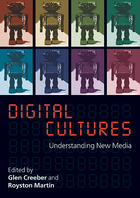Thomas Doherty: Cold War, Cool Medium: Television, McCarthyism, and American Culture (2003)
Filed under book | Tags: · cold war, film, history, mass media, politics, public broadcasting, television, united states

Conventional wisdom holds that television was a co-conspirator in the repressions of Cold War America, that it was a facilitator to the blacklist and handmaiden to McCarthyism. But Thomas Doherty argues that, through the influence of television, America actually became a more open and tolerant place. Although many books have been written about this period, Cold War, Cool Medium is the only one to examine it through the lens of television programming.
To the unjaded viewership of Cold War America, the television set was not a harbinger of intellectual degradation and moral decay, but a thrilling new household appliance capable of bringing the wonders of the world directly into the home. The “cool medium” permeated the lives of every American, quickly becoming one of the most powerful cultural forces of the twentieth century. While television has frequently been blamed for spurring the rise of Senator Joseph McCarthy, it was also the national stage upon which America witnessed—and ultimately welcomed—his downfall. In this provocative and nuanced cultural history, Doherty chronicles some of the most fascinating and ideologically charged episodes in television history: the warm-hearted Jewish sitcom The Goldbergs; the subversive threat from I Love Lucy; the sermons of Fulton J. Sheen on Life Is Worth Living; the anticommunist series I Led 3 Lives; the legendary jousts between Edward R. Murrow and Joseph McCarthy on See It Now; and the hypnotic, 188-hour political spectacle that was the Army-McCarthy hearings.
By rerunning the programs, freezing the frames, and reading between the lines, Cold War, Cool Medium paints a picture of Cold War America that belies many black-and-white clichés. Doherty not only details how the blacklist operated within the television industry but also how the shows themselves struggled to defy it, arguing that television was preprogrammed to reinforce the very freedoms that McCarthyism attempted to curtail.
Publisher Columbia University Press, 2003
ISBN 0231129521, 9780231129527
305 pages
PDF (updated on 2014-9-5)
Comment (0)Glen Creeber, Royston Martin (eds.): Digital Cultures: Understanding New Media (2008)
Filed under book | Tags: · digital cinema, digital divide, facebook, internet, mass media, media studies 2.0, new media, public broadcasting, public sphere, video games, wikipedia, youtube

From Facebook to the iPhone, from YouTube to Wikipedia, from Grand Theft Auto to Second Life – this book explores new media?s most important issues and debates in an accessible and engaging text for newcomers to the field.
With technological change continuing to unfold at an incredible rate, Digital Cultures rounds-up major events in the media?s recent past to help develop a clear understanding of the theoretical and practical debates that surround this emerging discipline. It addresses issues such as:
* What is new media?
* How is new media changing our lives?
* Is new media having a positive or negative effect on culture and human communication?
Each chapter contains case studies which provide an interesting and lively balance between the well-trodden and the newly emerging themes in the field.
Topics covered include digital television, digital cinema, gaming, digital democracy, mobile phones, the World Wide Web, digital news, online social networking, music and multimedia, virtual communities and the digital divide.
Digital Cultures is an essential introductory guide for all media and communication studies students, as well as those with a general interest in new media and its impact on the world around us.
Publisher Open University Press, 2008
ISBN 0335221971, 9780335221974
Length 205 pages
Vinod Pavarala, Kanchan K. Malik: Other Voices. The Struggle for Community Radio in India (2007)
Filed under book | Tags: · alternative media, civil society, community media, community radio, india, public broadcasting, radio

This book is a significant study of an emerging alternative media scene in India in the larger context of the globalization of mass communication. It explores community radio in India. When the trend globally is toward mergers, acquisitions, and concentration of ownership in fewer and fewer corporate hands, civil society organizations all over the world have been promoting such alternative, community-owned media.
This study investigates the ideologies and communication practices of various community-based organizations that have been using community radio as a means for empowerment at the grassroots. Adopting the case-study method, the authors do an in-depth analysis of four community radio projects in India-Andhra Pradesh, Karnataka, Gujarat and Jharkhand.
This book provides documentation of best practices in community broadcasting, and also appropriate frameworks for policy-making as it includes a comparative study of the policies related to community radio in liberal, democratic countries and a comprehensive assessment of the history of Indian policy-making in broadcasting.
Publisher Sage Publications, 2007
ISBN 0761936025, 9780761936022
Length 318 pages

